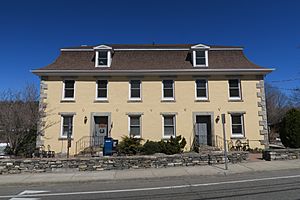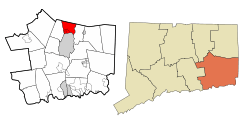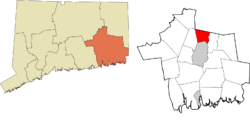Sprague, Connecticut facts for kids
Quick facts for kids
Sprague, Connecticut
|
||
|---|---|---|
| Town of Sprague | ||

Sprague Public Library
|
||
|
||
 New London County and Connecticut New London County and Connecticut |
||
| Country | ||
| U.S. state | ||
| County | New London | |
| Region | Southeastern CT | |
| Incorporated | 1861 | |
| Government | ||
| • Type | Selectman-town meeting | |
| Area | ||
| • Total | 13.8 sq mi (35.7 km2) | |
| • Land | 13.2 sq mi (34.2 km2) | |
| • Water | 0.6 sq mi (1.6 km2) | |
| Elevation | 276 ft (84 m) | |
| Population
(2020)
|
||
| • Total | 2,967 | |
| • Density | 215.0/sq mi (83.11/km2) | |
| Time zone | UTC-5 (Eastern) | |
| • Summer (DST) | UTC-4 (Eastern) | |
| ZIP Codes |
06330, 06350, 06383
|
|
| Area code(s) | 860/959 | |
| FIPS code | 09-71670 | |
| GNIS feature ID | 0213510 | |
Sprague is a small town in Connecticut, a state in the United States. It's located in New London County and is part of the Southeastern Connecticut Planning Region. The town got its name from William Sprague III, who helped start its industrial area.
According to the 2020 census, about 2,967 people live in Sprague. The town includes three smaller communities: Baltic, Hanover, and Versailles.
Contents
History of Sprague
The town of Sprague was officially created in 1861. It was formed from parts of two nearby towns, Lisbon and Franklin.
A few years before Sprague became a town, in 1856, a man named William Sprague III had big plans. He was a former Governor and Senator from Rhode Island. He wanted to build a very large mill in eastern Connecticut. Sadly, he passed away that same year.
His nephews, William and Amasa Sprague, continued his dream. They built the Baltic Cotton Mill in what is now the village of Baltic. This mill village was located right by the Shetucket River in the southwest part of town.
The original mill burned down in 1877. However, the Baltic Power Company kept operating a mill on the same spot until 1967.
Geography and Communities
Sprague covers a total area of about 13.8 square miles (35.8 square kilometers). Most of this area, about 13.2 square miles (34.2 square kilometers), is land. The rest, about 0.6 square miles (1.6 square kilometers), is water.
Main Communities in Sprague
Sprague has a few main communities that are important parts of the town:
The town hall, where local government business is done, is located in Baltic. It was built in the 1950s.
Population and People
| Historical population | |||
|---|---|---|---|
| Census | Pop. | %± | |
| 1870 | 3,463 | — | |
| 1880 | 3,207 | −7.4% | |
| 1890 | 1,106 | −65.5% | |
| 1900 | 1,339 | 21.1% | |
| 1910 | 2,551 | 90.5% | |
| 1920 | 2,500 | −2.0% | |
| 1930 | 2,539 | 1.6% | |
| 1940 | 2,285 | −10.0% | |
| 1950 | 2,320 | 1.5% | |
| 1960 | 2,509 | 8.1% | |
| 1970 | 2,912 | 16.1% | |
| 1980 | 2,996 | 2.9% | |
| 1990 | 3,008 | 0.4% | |
| 2000 | 2,971 | −1.2% | |
| 2010 | 2,984 | 0.4% | |
| 2020 | 2,967 | −0.6% | |
| U.S. Decennial Census | |||
In 2000, there were 2,971 people living in Sprague. These people lived in 1,111 households. About 797 of these households were families.
Many households, about 36.5%, had children under 18 living with them. About 54.2% of households were married couples. Around 21.2% of all households were made up of people living alone. About 8.8% of these were people aged 65 or older living by themselves.
The average household in Sprague had about 2.63 people. The average family had about 3.04 people.
The population of Sprague is spread out across different age groups. About 26.0% of the people were under 18 years old. About 11.7% were 65 years or older. The average age in town was 37 years.
Economy and Local Events
In the past, a big part of Sprague's economy was the Baltic Textile Mill. This mill, which was important for making fabrics, unfortunately burned down in 1999.
Ecotourism and Festivals
Sprague is becoming a popular spot for eco-tourism. This means people visit to enjoy nature and outdoor activities. The town has started holding a special event called RiverFest. This festival celebrates the local Shetucket River.
The river and the festival attract many outdoor enthusiasts. People enjoy kayaking, canoeing, and tubing on the river. It's also a great place for nature lovers to explore.
Another fun event is the Three Villages Festival. This festival happens every October in Baltic. It takes place on the public ball field and in the surrounding area.
Famous People from Sprague
Some notable people have connections to Sprague:
- Leo Connellan (1928–2001) was a poet. He was the poet laureate of Connecticut from 1996 to 2001. He lived his later years in Sprague and passed away there.
- Charles S. Whitman (1868–1947) was a judge. He also served as the 41st Governor of New York. He was born in Sprague.
- Chase Going Woodhouse (1890–1984) was a leader for women's rights. She was also an educator and a U.S. Representative.
Historic Places in Sprague
Several places in Sprague are listed on the National Register of Historic Places. This means they are important historical sites.
- Ashlawn – This historic building is located at 1 Potash Hill Road. It was added to the list on July 4, 1979.
- Baltic Historic District – This area includes many historic buildings. It's roughly bounded by Fifth Avenue, River, High, Main, West Main, and the Shetucket River. It was added on September 3, 1987.
- William Park House – This house is located at 330 Main Street. It was added to the list on March 7, 2007.
See also
 In Spanish: Sprague (Connecticut) para niños
In Spanish: Sprague (Connecticut) para niños



